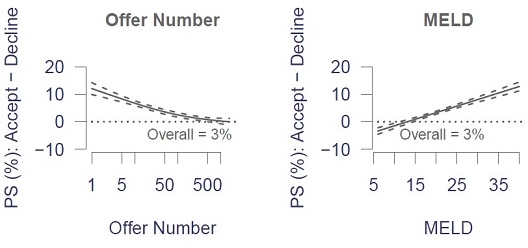Accepting a DCD Liver May Improve Patient Survival Compared to Waiting for a Non-DCD Liver
1Scientific Registry of Transplant Recipients, Minneapolis
2Univ of Minnesota, Minneapolis
3Stanford University, Palo Alto.
Meeting: 2018 American Transplant Congress
Abstract number: 352
Keywords: Allocation, Donation, Prediction models, Survival
Session Information
Session Name: Concurrent Session: Liver: MELD, Allocation and Donor Issues - 1
Session Type: Concurrent Session
Date: Monday, June 4, 2018
Session Time: 4:30pm-6:00pm
 Presentation Time: 4:42pm-4:54pm
Presentation Time: 4:42pm-4:54pm
Location: Room 6B
Only ~50% of liver candidates undergo deceased donor transplant; 17% die on the waiting list and 20% are removed from the list as too sick for transplant within 3 years of listing. Despite high rates of waitlist mortality and dropout, 30% of recovered donation after circulatory death (DCD) livers were discarded in 2015. DCD livers provide an opportunity for donor pool expansion but are associated with lower posttransplant survival. Thus, they may not confer a survival benefit to all candidates. Using SRTR data, we developed a liver offer acceptance decision tool and evaluated the potential survival benefit of DCD livers across the spectrum of candidate allocation priority, i.e., model for end-stage liver disease (MELD) scores. Probability of patient survival (PS) for declining an offer was estimated by considering waitlist experience of similar candidates who declined offers and the probability that such experiences would lead to patient survival 1 year after the declined offer. We used offers from deceased donors recovered January 1-December 31, 2013. Posttransplant survival models used recipients who underwent transplant May 1, 2007-June 30, 2016. The difference in patient survival for accepting versus declining a DCD donor offer was estimated with 5000 randomly selected declined offers, 407 of which were from DCD donors. Acceptance of DCD offers was predicted to confer a 3% survival benefit after 1 year compared with declining, although the benefit strongly depended on MELD score (Figure 1). Declining a DCD donor offer and restricting the donor pool to DBD donors did not improve the probability of patient survival. Thus, DCD donors are an opportunity to expand the donor pool while conferring a survival benefit for candidates.
Figure 1. The difference in the estimated probability of 1-year patient survival (PS) for accepting a DCD liver versus declining and remaining on the waiting list. A solid line above 0 indicates that accepting the DCD liver conferred a higher probability of PS after 1 year versus remaining on the waitlist.
CITATION INFORMATION: Wey A., Salkowski N., Lake J., Kim W., Kasiske B., Israni A., Snyder J. Accepting a DCD Liver May Improve Patient Survival Compared to Waiting for a Non-DCD Liver Am J Transplant. 2017;17 (suppl 3).
To cite this abstract in AMA style:
Wey A, Salkowski N, Lake J, Kim W, Kasiske B, Israni A, Snyder J. Accepting a DCD Liver May Improve Patient Survival Compared to Waiting for a Non-DCD Liver [abstract]. https://atcmeetingabstracts.com/abstract/accepting-a-dcd-liver-may-improve-patient-survival-compared-to-waiting-for-a-non-dcd-liver/. Accessed December 10, 2025.« Back to 2018 American Transplant Congress
